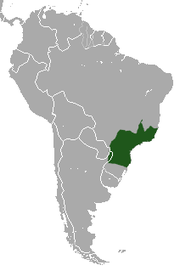| Robust capuchin monkey [1] Temporal range: Late Miocene to present | |
|---|---|
 | |
| Four species of robust capuchins, from top to bottom, from left to right: S. flavius , S. xanthosternos , S. nigritus , S. libidinosus | |
| Scientific classification | |
| Kingdom: | Animalia |
| Phylum: | Chordata |
| Class: | Mammalia |
| Order: | Primates |
| Suborder: | Haplorhini |
| Infraorder: | Simiiformes |
| Family: | Cebidae |
| Subfamily: | Cebinae |
| Genus: | Sapajus Kerr, 1792 |
| Type species | |
| Simia apella | |
| Species | |
 | |
| Range of robust capuchin monkeys S. apella S. cay S. flavius S. libidinosus S. macrocephalus S. nigritus S. robustus S. xanthosternos Contents | |
Robust capuchin monkeys are capuchin monkeys in the genus Sapajus. Formerly, all capuchin monkeys were placed in the genus Cebus . Sapajus was erected in 2012 by Jessica Lynch Alfaro et al. to differentiate the robust (tufted) capuchin monkeys (formerly the C. apella group) from the gracile capuchin monkeys (formerly the C. capucinus group), which remain in Cebus. [1] [2]



















